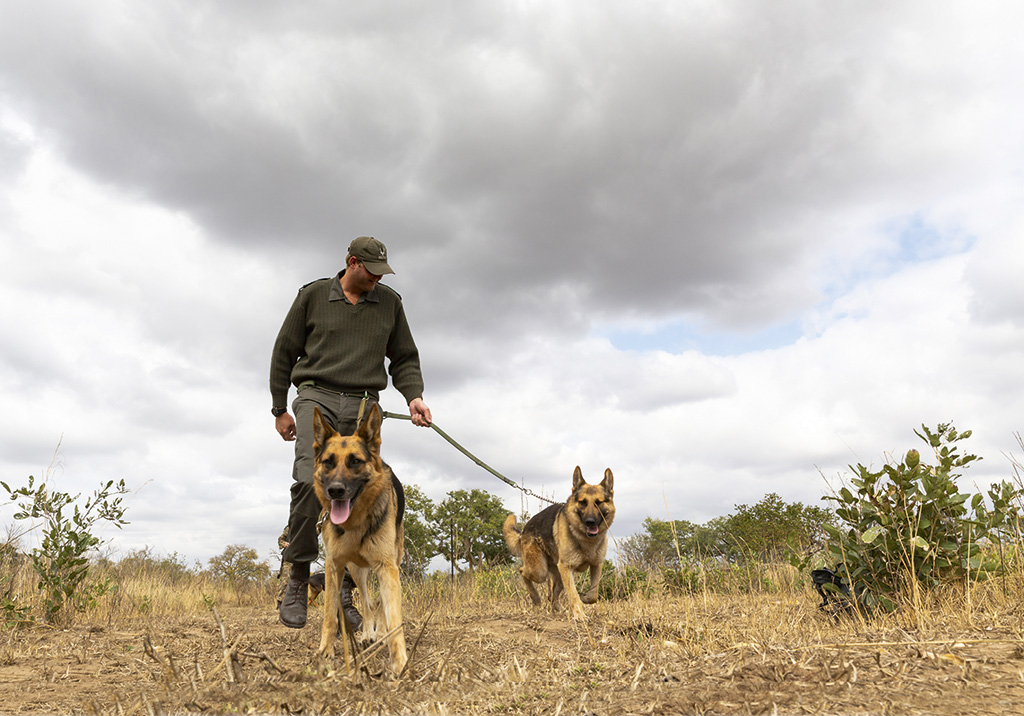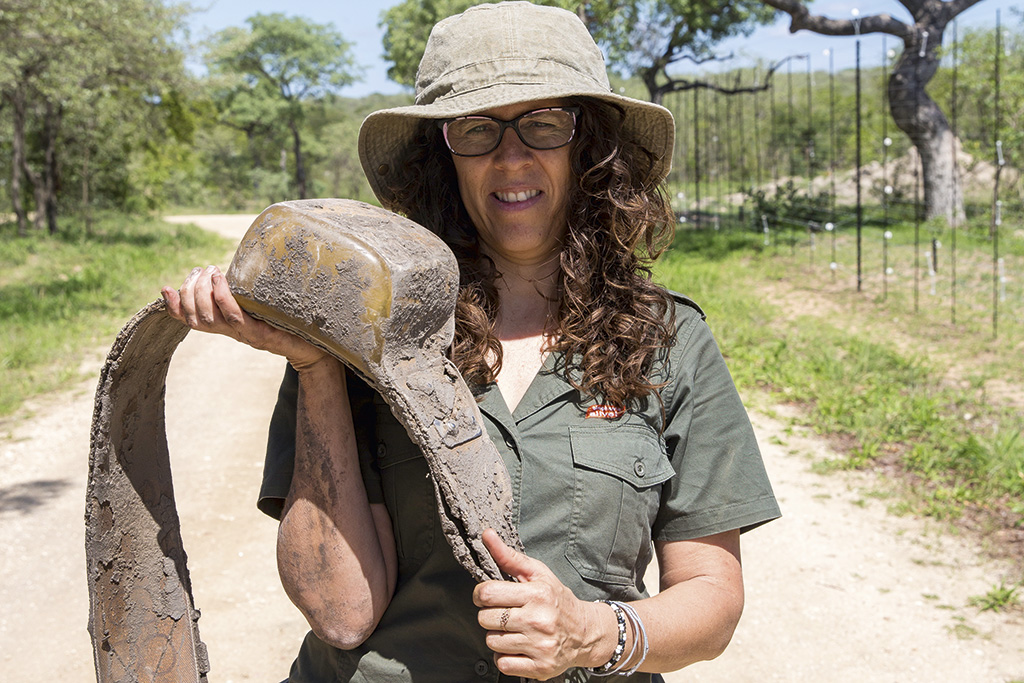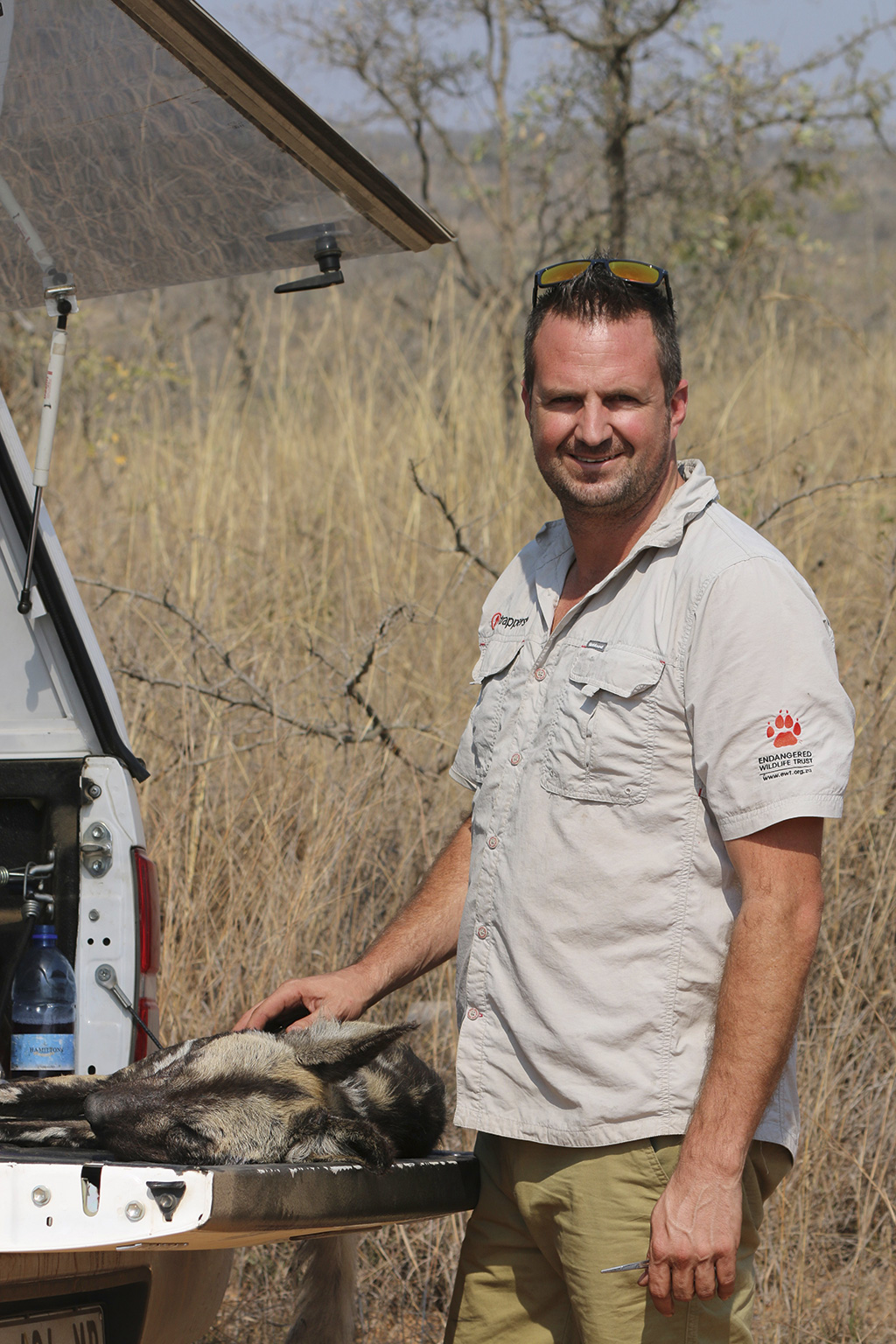Who heads up the park’s 700-plus rangers? Who researches and helps threatened species to ensure their survival? And who’s on call to treat humans? Zoologist Harriet Nimmo meets five dedicated Kruger personalities.

An anti-poaching ranger (who may not be identified) based at Skukuza’s K9 Unit, with his German shepherds – one is trained to sniff out concealed rhino horn and ivory, the other to detect firearms and ammunition.
The Toughest Job
I met with chief ranger Xolani Nicholas Funda at Skukuza HQ’s MAJOC (Mission Area Joint Operations Command) offices. A wise and charismatic man, it struck me that he must have one of the most difficult jobs in Kruger. He oversees all counter-poaching operations and is responsible for the safety and well-being of more than 700 rangers stationed across the park. His team works shifts of up to 21 days at a time in the bush, fighting against hardened criminals while having to conduct themselves according to the law. The rangers are increasingly involved in armed skirmishes with poachers.
‘One of my many roles is to ensure that all rangers are well equipped and trained in paramilitary techniques, to deal with poachers,’ says Xolani. ‘The criminals we intercept are well armed.’ The number of poached rhinos has shown a small decrease over the last two years. This could, of course, be because there are fewer rhino and they’re harder to find, but Xolani reported that they’re making more arrests and confiscating greater numbers of weapons. Those currently being caught are younger and less experienced, as many well-known poachers are already in custody. ‘We have a whole toolkit of resources, including aerial surveillance with fixed-wing planes and helicopters, canine units and up-to-date technology, such as night-time surveillance and military-standard detection equipment. But none of this replaces boots on the ground – skilled rangers on the frontline – although they can now call in choppers and dogs for backup.’

Xolani Nicholas Funda, head of Kruger’s counter-poaching operations.
But incursions continue and indiscriminate snaring is also becoming a big problem. ‘Snaring is to get bushmeat, but it’s not for the pot,’ says Xolani. ‘It’s a serious commercial enterprise about greed, not hunger.’ Honorary Rangers are now helping SANParks to search for snares in key border areas, and with fundraising. Xolani believes that ultimately the battle will only be won in the courts. ‘It’s imperative that the Department of Justice is more effective, with more prosecutions and convictions. Too many traffickers are getting off with just a fine, and too many syndicate leaders are out on bail.’ Xolani is working hard to build alliances with SAPS and the Department of Justice, and has been encouraged that a senior judge in Mpumulanga gave the keynote at a recent Ranger Services AGM. ‘But, unfortunately, rhino poaching is not a government priority – it doesn’t win votes, ‘ he says. ‘Our government needs to confront the Asian embassies in this country, but this is very difficult when we consider the trade deals being done.’
Xolani believes that we need greater public condemnation of the loss of our wildlife. ‘This is our country’s heritage, and we need to tell a better story to the local communities about the park’s benefits,’ he says. Kruger employs 2 400 locals and tourism increases every year, with many of its bordering towns tourism-based. SANParks has a ‘People and Conservation’ division to help improve relationships with local communities, especially the youth. Xolani, originally a Kruger field ranger, spent 10 years lecturing at the University of Tshwane in the Department of Nature Conservation. He returned to SANParks to become the head of Ranger Services in 2015. Despite now being mainly office-based, building strategic relations, his heart still lies with his team in the bush. Tragically, one of his rangers was murdered by poachers in
the Crocodile Bridge area last year, and in January three SANParks rangers were arrested on suspicion of poaching, all of which was devastating to Xolani. I asked him why he took the job, when it seems such an impossible task, not to mention disheartening.
‘I believe I have a moral responsibility to save Africa’s wildlife and to do what I’m doing as a citizen of South Africa and the world. We owe this to our country, to future generations and to the international community. And we are making a difference.

TOP, FROM LEFT The health status of Kruger’s wild dogs is monitored twice a year, following the outbreak of canine distemper in 2016; another member of Skukuza’s K9 Unit, this bloodhound is trained to track poachers. BOTTOM, FROM LEFT Local children are invited to spend a day tracking elephants as part of Elephants Alive’s outreach programme; ‘Classic’, a mature bull elephant in his prime, was first collared by Elephants Alive in 2004.
Protecting Our Ellies
I count myself lucky to have spent the last three years working with Elephants Alive, under the leadership of co-founder, CEO and principal researcher Dr Michelle Henley. She says her biggest challenge ‘is advising on how to best manage expanding populations in fenced reserves in SA, while also educating people on the alarming pan-African decline of elephants.’ For 20 years, this NGO has been studying the elephants of the Greater Kruger to ensure their survival and promote harmony with humans.
Kruger is home to one of Southern Africa’s largest free-ranging elephant populations. With the fences down, they can move throughout the Great Limpopo Transfrontier Park, which includes Kruger National Park and private nature reserves bordering the park (Timbavati, Klaserie, Umbabat, Balule and Thornybush) in South Africa, Gonarezhou National Park in Zimbabwe and Limpopo National Park in Mozambique.

Dr Michelle Henley holds an elephant collar.
Elephants Alive has developed an identification database of nearly 2 000 elephants, which includes their sex, ear patterns (tears, notches, holes) and the shape of their tusks. They have also named and radio-collared 80 elephants to follow their movements in greater detail. The focus is on mature bulls as much less is known about male elephants, and this long-term research is providing fundamental information for elephant management and protection. elephantsalive.org
Safeguarding Wild Dogs
Living in the small bush town of Hoedspruit, Grant Beverley, Lowveld Carnivore Coordinator for the Endangered Wildlife Trust (EWT), has been striving to save wild dogs for the past 10 years. ‘African wild dogs seem to have undergone a positive PR transformation in recent years, and they’re top of sighting wish lists for more and more Kruger visitors these days,’ says Grant.
‘However, they can prove infuriatingly tricky to spot, as they cover huge distances each day, never stopping for long in one area unless they happen to be denning.’
Wild dogs are South Africa’s rarest carnivore. It’s estimated there are only 450 in the whole country, of which half are found in Kruger. EWT has been monitoring Kruger’s wild dogs since 1995, and Grant has headed up this research project since 2010. Wild dog numbers have decreased significantly in the north of the park since 1995. It’s not known why exactly, but key threats include snaring and disease. In September 2017, EWT led a pioneering reintroduction programme in the north, releasing a pack of eight dogs in the Shingwedzi area, all of which were fitted with tracking collars. The pack has moved over the border into Limpopo National Park in Mozambique and denned successfully.
Grant is also coordinating the Wild Dog Range Expansion Project in the Lowveld, where two more packs have successfully been reintroduced into private reserves bordering Kruger, with another reintroduction planned soon in Mozambique. ewt.org.za

Grant Beverley, of the Endangered Wildlife Trust, successfully removing a snare from an anaesthetised wild dog.
You Can Help
Report sightings and send photographs to [email protected].
What’s Up, Doc?
Dr Julia Dabrowski has been based at Skukuza for three years, running Kruger Park Doctors with her colleague, Dr Nardus Visser. ‘My job is so varied’ she says. ‘I never know who is going to walk through my surgery door. We’re also on call 24/7, and most of my patients are SANParks staff – I love getting to know them and their families. Of course, I also treat lots of tourists – some international visitors are very anxious about being “in the wilds of Africa”.’
She has also peered sympathetically at numerous mosquito bites, reassuring guests that malaria is not instantaneous, and remembers having to chase after a hallucinating tourist, clad only in his underpants, around Skukuza Rest Camp at 2am, while clutching her doctor’s bag. ‘It was not how I’d imagined my job would be!’ she says. ‘I was newly arrived and the guest was experiencing a diabetes-induced delirium. Thankfully I managed to subdue and treat him and he made a full recovery.’ Julia is also called out at night to deal with injuries sustained during poaching incidents. ‘It’s my duty to treat poachers as well as our SANPark rangers.’
She loves living at Skukuza with her husband and young children, who go to the camp’s nursery school. ‘There’s such a wonderful community of like-minded souls here,’ she told me. The family live in the staff village, which is unfenced, and they are used to waking up in the night to find hippos on their lawn and hearing elephants munching outside their bedroom windows.
013-735-5638, krugerdoctors.co.za

Dr Julia Dabrowski, of Kruger Park Doctors, in her surgery at Skukuza.
Tracking Martial Eagles
Waving a 12-metre-long aluminium pole in the air with a thunderstorm approaching was probably not the most sensible thing to do in Kruger. I was spending two days with Dr Megan Murgatroyd, helping her survey martial eagle nest sites in the Phalaborwa/Letaba area. Megan leads the FitzPatrick Institute of African Ornithology’s Martial Eagle Research Project.
Taped to the top of the long pole was a GoPro camera and we were trying to angle it to record any eggshell fragments, food or chick remains in an abandoned nest at the top of a leadwood tree. In 2011, a decrease of up to 60 percent of this iconic raptor, the largest of the African eagles, was identified. Some 66 nests were located in Kruger and a sample of these has been monitored since 2013. GPS trackers have been fitted to 10 adults and nine immature eagles to record their movements.
Four adults ranged far beyond Kruger’s borders, two were killed by subsistence hunters in Mozambique, one was electrocuted on power lines in eSwatini, and two died of natural causes within the park. A further 26 martial eagles have been ringed to provide more information on movement and survival rates. When dispersing, juveniles are expected to use larger areas than adults, and are, perhaps, more likely to encounter threats outside protected areas. So far, the study has shown a reasonably good survival rate for tracked juvenile eagles. This suggests that the high adult mortality rate may have been by chance, and further long-term research is needed. Meanwhile, Megan continues to monitor the nests each year.

Dr Megan Murgatroyd trying to examine an abandoned martial eagle nest.
You Can Help
Report any sightings of ringed martial eagles. Send the date, time, location and a photograph to [email protected].
You may also like
Related Posts
China’s National Health Commission has published a list of controversial coronavirus treatments that have animal...
read more
Warmer sea temperatures in the summer months, especially in February, were recorded and are believed...
read more
While people are stuck indoors due to the coronavirus pandemic, the penguins at the Two...
read more